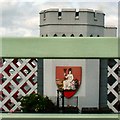Ethelfleda Bridge

There is a bridge here which takes a railway over the canal.
| Factory Lane Pipe Bridge | 7 miles, 4 furlongs | |
| Forrest Way Bridge | 6 miles, 6½ furlongs | |
| Mersey Gateway Bridge | 1 mile, 2 furlongs | |
| Mersey - Sankey Junction | 4¼ furlongs | |
| Silver Jubilee Bridge | ¼ furlongs | |
| Ethelfleda Bridge | ||
| Mersey - Ship Canal Junction | 13 miles, 4 furlongs | |
| Stalbridge Dock Entrance | 14 miles, 1¼ furlongs | |
| Mersey - South Docks Junction | 15 miles, 2 furlongs | |
| Prince's Half Tide Dock Entrance | 17 miles, 2 furlongs | |
| Salisbury Dock Entrance | 17 miles, 7¾ furlongs | |
Why not log in and add some (select "External websites" from the menu (sometimes this is under "Edit"))?
Mouseover for more information or show routes to facility
Nearest water point
In the direction of River Mersey Entrance
In the direction of Irwell Navigation Junction
Nearest rubbish disposal
In the direction of River Mersey Entrance
In the direction of Irwell Navigation Junction
Nearest chemical toilet disposal
In the direction of Irwell Navigation Junction
Nearest place to turn
In the direction of River Mersey Entrance
In the direction of Irwell Navigation Junction
No information
CanalPlan has no information on any of the following facilities within range:self-operated pump-out
boatyard pump-out
Wikipedia has a page about Ethelfleda Bridge
The Runcorn Railway Bridge, Ethelfleda Bridge or Britannia Bridge crosses the River Mersey at Runcorn Gap between Runcorn and Widnes in Cheshire, England. It is alongside the Silver Jubilee Bridge. The bridge is recorded in the National Heritage List for England as a Grade II* Listed building.
In 1861, Parliamentary approval for a railway crossing the Mersey was obtained by the London and North Western Railway (LNWR). The design for a bridge and viaducts was produced by William Baker, the company's chief engineer. In 1863, preparatory work for the bridge and approach viaducts commenced. The bridge was completed in 1868 and was opened for traffic on 10 October. The first goods traffic crossed the bridge on 1 February 1869 and the first passenger train on 1 April.
The bridge has received few alterations. In 1965, the pedestrian footway alongside the railway was closed to the public but retained for maintenance access. The bridge is used by rail traffic on the Liverpool branch of the West Coast Main Line. The lines are electrified and 25 kV AC overhead lines installed. Starting in the 2010s, the bridge has undergone a lengthy maintenance programme that will extend its life for another 150 years.

![Runcorn Bridges. The Runcorn Railway Bridge, which is also known as the Ethelfleda Bridge or the Britannia Bridge, crosses the River Mersey at Runcorn Gap from Runcorn to Widnes. It was originally built for the London and North Western Railway (LNWR) Company and opened in 1868. The bridge consists of three wrought iron spans of 305 feet (93 m), each on two sandstone abutments. From the north side of the river the bridge is approached by a viaduct of 49 arches, then a short piece of embankment, followed by 16 more arches. From the south it is approached by a viaduct of 33 arches. On its completion, the bridge was the longest of its time.The bridge is designated by English Heritage as a Grade II* listed building (https://historicengland.org.uk/listing/the-list/list-entry/1130418 National Heritage List for England).Behind the railway bridge is the more recent Silver Jubilee road bridge ([[[3435213]]]), itself a Grade II listed structure, which opened in 1961. by David Dixon – 26 April 2013](https://s2.geograph.org.uk/geophotos/03/43/52/3435254_6d5ea90a_120x120.jpg)




![The Widnes-Runcorn Bridges over The River Mersey. The Runcorn Railway Bridge, which is also known as the Ethelfleda Bridge or the Britannia Bridge, crosses the River Mersey at Runcorn Gap from Runcorn to Widnes. It was originally built for the London and North Western Railway (LNWR) Company and opened in 1868. The bridge consists of three wrought iron spans of 305 feet (93 m), each on two sandstone abutments. From the north side of the river the bridge is approached by a viaduct of 49 arches, then a short piece of embankment, followed by 16 more arches. From the south it is approached by a viaduct of 33 arches. On its completion, the bridge was the longest of its time.The bridge is designated by English Heritage as a Grade II* listed building (https://historicengland.org.uk/listing/the-list/list-entry/1130418 National Heritage List for England).Behind the railway bridge is the more recent Silver Jubilee road bridge ([[[3435213]]]), itself a Grade II listed structure, which opened in 1961. by David Dixon – 26 April 2013](https://s1.geograph.org.uk/geophotos/03/43/52/3435285_487d6e76_120x120.jpg)













![Runcorn (Britannia) Railway Bridge. The Runcorn Railway Bridge, which is also known as the Ethelfleda Bridge or the Britannia Bridge, crosses the River Mersey at Runcorn Gap from Runcorn to Widnes. It was originally built for the London and North Western Railway (LNWR) Company and opened in 1868. The bridge consists of three wrought iron spans of 305 feet (93 m), each on two sandstone abutments. From the north side of the river the bridge is approached by a viaduct of 49 arches, then a short piece of embankment, followed by 16 more arches. From the south it is approached by a viaduct of 33 arches. On its completion, the bridge was the longest of its time.The bridge is designated by English Heritage as a Grade II* listed building (https://historicengland.org.uk/listing/the-list/list-entry/1130418 National Heritage List for England).Behind the railway bridge is the more recent Silver Jubilee road bridge ([[[3435213]]]), itself a Grade II listed structure, which opened in 1961. by David Dixon – 26 April 2013](https://s3.geograph.org.uk/geophotos/03/43/52/3435275_4101227c_120x120.jpg)









